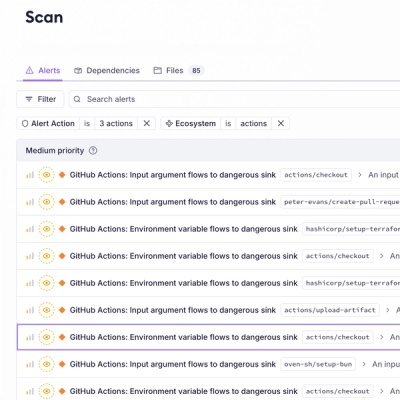
Product
Introducing Socket Firewall Enterprise: Flexible, Configurable Protection for Modern Package Ecosystems
Socket Firewall Enterprise is now available with flexible deployment, configurable policies, and expanded language support.
@ledgerhq/coin-evm
Advanced tools
How to integrate a new EVM family currency in the Ledger Live application.
This document will outline the different steps needed to implement a new EVM family currency in the Ledger Live application. Depending on the specifications, some steps might not be needed for all currencies.
Most EVM coin integrations are quite similar. The main specs will be outlined below. But each coin may have its specificities and more information can be found on the specific coin integration Jira Epic created for each integration, based on this template https://ledgerhq.atlassian.net/browse/LIVE-10187
Here is an example PR of an EVM currency integration: https://github.com/LedgerHQ/ledger-live/pull/4008
Common steps for all new EVM currency integration
libs/ledgerjs/packages/cryptoassets/src/currencies.tsCryptoCurrencyId type under libs/ledgerjs/packages/types-cryptoassets/src/index.tsabandonSeedAddresses (using the currency ID as key and EVM_DEAD_ADDRESS as value) under libs/ledgerjs/packages/cryptoassets/src/abandonseed.tssetSupportedCurrencies function param on each relevant project (CLI, LLD, LLM and LLC test environement)CurrencyFeatures type under libs/ledgerjs/packages/types-live/src/feature.tsCURRENCY_DEFAULT_FEATURES mapping under libs/ledger-live-common/src/featureFlags/defaultFeatures.tspnpm doc under libs/ledgerjs/packages/types-live to update the docpnpm test:jest under apps/ledger-live-desktop to update the snapshotslibs/ui/packages/crypto-icons/src/svg folder within the @ledgerhq/icons-ui package
{currency_ticker}.svg naming conventionOptional / extra steps that might be needed on a case-by-case basis depending on the integration
libs/coin-modules/coin-evm/src/network/explorer foldergetExplorerApi function under libs/coin-modules/coin-evm/src/network/explorer/index.tsEthereumLikeInfo.explorer.type type under libs/ledgerjs/packages/types-cryptoassets/src/index.tsisEtherscanLikeExplorerConfig type guard under libs/coin-modules/coin-evm/src/network/explorer/types.ts (this is the case for some custom made explorers that are not blockscan white label implementation, but are still compatible with the blockscan/etherscan API)Here are the steps to handle the new currencies (ERC20) tokens, if relevant:
{chainId} with the actual currency chain ID, specified under ethereumLikeInfo.chainId in the currency config (under libs/ledgerjs/packages/cryptoassets/src/currencies.ts) which would be 1 for ethereum mainnet for example, using https://cdn.live.ledger.com/cryptoassets/evm/{chainId}/erc20.jsonNo change should be needed on Ledger Live side since tokens are automatically imported from CAL at the release stage, cf:
.github/workflows/test-release-create.ymlimport:cal-tokens job in the ledger-js packageTo have the associated market (fiat) price supported for the network being added, some config updates are needed on the CAL and countervalue service sides.
The process for this can be found here: https://ledgerhq.atlassian.net/wiki/spaces/WALLETCO/pages/4354769042/Adding+price+support+for+a+currency
The new network being added needs to be handled by the nano ethereum app.
Make sure the network being added is present under the network_info_t mapping in src_common/network.c (here for staging and here for prod).
In Ledger Live, make sure the ethereum nano app version requirements match the latest version of the ethereum app handling the network being added:
appVersion in getAppQuery under libs/coin-modules/coin-evm/src/specs.tsEthereum in appVersionsRequired under libs/ledger-live-common/src/apps/support.tslibs/ledger-live-common/src/apps/support.test.tsminBalancePerCurrencyId under libs/coin-modules/coin-evm/src/specs.tsThe bare minimum to test in terms of flows is, on both LLD and LLM:
Make sure to add the newly created currency feature flag to the Firebase config
FAQs
Ledger EVM Coin integration
The npm package @ledgerhq/coin-evm receives a total of 1,454 weekly downloads. As such, @ledgerhq/coin-evm popularity was classified as popular.
We found that @ledgerhq/coin-evm demonstrated a healthy version release cadence and project activity because the last version was released less than a year ago. It has 7 open source maintainers collaborating on the project.
Did you know?

Socket for GitHub automatically highlights issues in each pull request and monitors the health of all your open source dependencies. Discover the contents of your packages and block harmful activity before you install or update your dependencies.

Product
Socket Firewall Enterprise is now available with flexible deployment, configurable policies, and expanded language support.

Security News
Open source dashboard CNAPulse tracks CVE Numbering Authorities’ publishing activity, highlighting trends and transparency across the CVE ecosystem.

Product
Detect malware, unsafe data flows, and license issues in GitHub Actions with Socket’s new workflow scanning support.